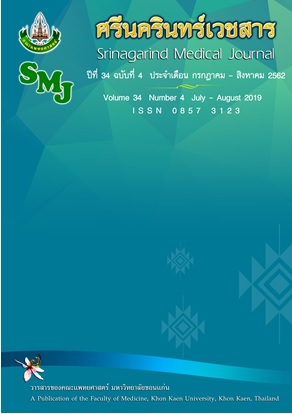Histological Alterations of the Urinary Tract Infection by Escherichia coli from Urinary Catheter
Keywords:
การเปลี่ยนแปลงทางจุลกายวิภาค; การติดเชื้อทางเดินปัสสาวะ; เชื้อ Escherichia coli; สายสวนปัสสาวะAbstract
Catheter-associated urinary tract infection (CAUTI) is a common public health problem in worldwide. In normal conditions, the urinary tract is a sterile environment. The mucosa of the urinary tract acts as a natural protective barrier that prevents microbial adhesion and invasion into the body. In indwelling catheterized patient, indwelling catheter affects the urinary mucosa to be injured, inflamed, damaged, and then enhancing bacterial adhesion. When the contaminated Uropathogenic Escherichia coli (UPEC) entry to the body through the catheter. The UPEC is able to adhere and grow on the surface of the catheter and multiplies itself then invades into other tissue layers of the body results in the significantly increases the incident of morbidity and mortality. Therefore, the studying about histological alteration of the urinary bladder after catheterization and the mechanism of UPEC infection are able to be a basic knowledge and benefit for anyone interested to study for improving the effective strategy in prevention and treatment of CAUTI.
References
2. Kotikula I, Chaiwarith R. Epidemiology of catheter-associated urinary tract infections at Maharaj nakorn Chiang mai hospital, northern thailand. Southeast Asian J Trop Med Public Health 2018; 49: 113-22.
3. McLellan LK, Hunstad DA. Urinary tract infection: pathogenesis and outlook. Trends Mol Med 2016; 22: 946-57.
4. Jacobsen Sá, Stickler D, Mobley H, Shirtliff M. Complicated catheter-associated urinary tract infections due to Escherichia coli and Proteus mirabilis. Clin Microbiol Rev 2008; 21 :26-59.
5. Blodgett TJ, Gardner SE, Blodgett NP, Peterson LV, Pietraszak M. A tool to assess the signs and symptoms of catheter-associated urinary tract infection: development and reliability. Clin Nurs Res 2015; 24: 341–56.
6. Glover M, Moreira CG, Sperandio V, Zimmern P. Recurrent urinary tract infections in healthy and nonpregnant women. Urol Sci 2014; 25: 1-8.
7. Flores-Mireles AL, Walker JN, Caparon M, Hultgren SJ. Urinary tract infections: epidemiology, mechanisms of infection and treatment options. Nat Rev Microbiol 2015; 13: 269-84.
8. Best J, Kitlowski AD, Ou D, Bedolla J. Diagnosis and management of urinary tract infections in the emergency department. Emerg Med Pract 2014; 16: 1-23.
9. Iacovelli V, Gaziev G, Topazio L, Bove P, Vespasiani G, Finazzi Agrò E. Nosocomial urinary tract infections: a review. Urologia 2014; 81: 222-7.
10. Conover MS, Flores-Mireles AL, Hibbing1 ME, Dodson K, Hultgren S J. Establishment and Characterization of UTI and CAUTI in a Mouse Model. J Vis Exp 2015 [cited 2018 Aug 28]; 100: [about 12p.]. Available from: https://www.jove.com/52892.
11. Armbruster CE, Prenovost K, Mobley HLT, Mody L. How Often Do Clinically Diagnosed Catheter-associated Urinary Tract Infections in Nursing Homes Meet Standardized Criteria? J Am Geriatr Soc 2017 ; 65: 395–401.
12. Bien J, Sokolova O, Bozko P. Role of Uropathogenic Escherichia coli Virulence Factors in Development of Urinary Tract Infection and Kidney Damage. International Journal of Nephrology 2012 [cited 2018 Aug 28]; Article ID 681473:[about 15p.]. Available from: https://www.hindawi.com/journals/ijn/2012/681473.
13. Guiton PS, Cusumano CK, Kline KA, Dodson KW, Han Z, Janetka JW, et al. Combinatorial Small-Molecule Therapy Prevents Uropathogenic Escherichia coli Catheter-Associated Urinary Tract Infections in Mice. Antimicrob Agents Chemother 2012; 56: 4738–45.
14. Rousseau M, Goh Shn, Holec S, Albert ML., Williams RBH, Ingersoll AM, et al. Bladder catheterization increases susceptibility to infection that can be prevented by prophylactic antibiotic treatment. JCI Insight 2016 [cited 2018 Aug 28]; 1(15): [about 13p.]. Available from: https://doi.org/10.1172/jci.insight.88178.
15. Lassek Ch, Burghartz M, Diego ChM, Otto As, Hentschker Ch, Fuchs Sn,et al. A Metaproteomics Approach to Elucidate Host and Pathogen Protein Expression during Catheter-Associated Urinary Tract Infections(CAUTIs). Mol Cell Proteomics 2015; 14: 989–1008.
16. Reisner A, Maierl M, Jörger M, Krause R, Berger D, Haid A, et al. Type 1 Fimbriae Contribute to Catheter-Associated Urinary Tract Infections Caused by Escherichia coli. J Bacteriol 2014; 196: 931–9.
17. Trautner BW, Darouiche RO. Role of biofilm in catheter-associated urinary tract infection. Am J Infect Control 2004; 32: 177–83.
18. Lo E, Nicolle LE, Coffin SE, Gould C, Maragakis LL, Meddings J, et al. Strategies to prevent catheter-associated urinary tract infections in acute care hospitals: 2014 update. Infect Control Hosp Epidemiol. 2014; 35: 464-79.
19. Trautner BW, Hull RA, Darouiche RO. Prevention of catheter-associated urinary tract infection. Curr Opin Infect Dis 2005; 18: 37-41.
20. Trautner BW. Management of Catheter-Associated Urinary Tract Infection (CAUTI). Curr Opin Infect Dis 2010; 23: 76–82.
21. Saint S, Greene T, Kowalski CP, Watson SR, Hofer TP, Krein SL. Preventing Catheter-Associated Urinary Tract Infection in the United States: A National Comparative Study. JAMA Intern Med 2013; 173: 874–9.
22. Uppanisakorn S., Boonyarat J., Thikong A. Prevention of Medical Intensive Care Unit (ICU) Patients’ Urinary Tract Infection Caused by Retained Urethral Catheterization. Thai Journal of Nursing Council 2012; 27: 49-62.



